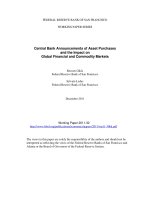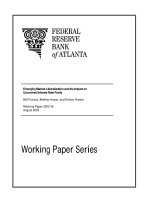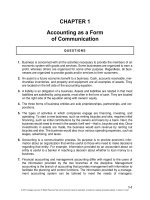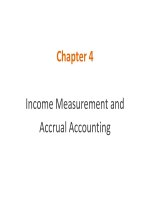Financial accounting the impact on decision makers 9e chapter 3
Bạn đang xem bản rút gọn của tài liệu. Xem và tải ngay bản đầy đủ của tài liệu tại đây (1.22 MB, 38 trang )
Chapter 3
Processing Accounting
Information
External and Internal Events
Event: a happening
of consequence to an entity
External event: interaction between an entity
and its environment
Internal event: occurs entirely within an entity
Transaction: any event, external or internal, that
is recognized in a set of financial statements
LO 1
Role of Source Documents in an
Accounting System
Source
document: used as evidence to record a
transaction
Different Forms:
Purchase Invoice
Sales Invoice
Cash register tape
Time cards
LO 2
Analyze the Effects of Transactions
on the Accounting Equation
Accounting
equation:
Assets =Liabilities + Stockholders’ Equity
Issuance of Capital Stock
Glengarry
Health Club is started when Karen
Bradley and Kathy Drake file articles of
incorporation with the state to obtain a charter.
Each invests $50,000 in the business. In return,
each receives 5,000 shares of capital stock
Acquisition of Property in
Exchange for a Note
Company
buys a piece of property for $200,000.
The seller agrees to accept a five-year
promissory note. The property consists of land
valued at $50,000 and a newly constructed
building valued at $150,000
Acquisition of Equipment on an
Open Account
Karen and
Kathy contact an equipment supplier
and buy $20,000 of exercise equipment:
treadmills, barbells, and stationary bicycles. The
supplier agrees to accept payment in full in 30
days
Sale of Monthly Memberships on
Account
During
January, the owners sell 300 monthly
club memberships for $50 each, or a total of
$15,000. The members have until the 10th of
the following month to pay
Sale of Court Time for Cash
In
addition to memberships, Glengarry sells
court time. Court fees are paid at the time of
use and amount to $5,000 for the first month
Payment of Wages and Salaries
Wages
and salaries for the first month amount
to $10,000
Payment of Utilities
Cost
of utilities for the first month is $3,000.
Glengarry pays this amount in cash
Collection of Accounts Receivable
Amount
received from members in payment of
their accounts is $4,000
Payment of Dividends
Karen and
Kathy, acting on behalf of Glengarry
Health Club, decide to pay a dividend of $1,000
on the shares of stock that each of them owns,
or $2,000 in total
Cost Principle
Requires
assets such as equipment to be
recorded at cost to acquire and continue to
report this amount on all balance sheets until
the asset is disposed
These assets are not carried at market value,
but at original cost (with few exceptions)
Accounts
Account: record
used to accumulate monetary
amounts for each asset, liability, revenue,
expense, and component of stockholders’
equity
Chart of Accounts: numerical list of all of the
accounts an entity uses
LO 4
The General Ledger
A
book, a file, a hard drive, or another device
containing all of the accounts
Identify and Analyze
The
accounting equation is the basis for
financial statements
For every transaction, three questions must be
answered:
1.
2.
3.
What type of activity did the transaction reflect?
What accounts are affected by the transaction, and
are they increased or decreased?
Which financial statements are affected by the
transaction?
Identify and Analyze
Wages
and salaries for the first month amount
to $10,000 for Glengarry
T account
T
Account: format for showing amounts coming
into and leaving an account
Example 3.2—Using a T Account
Debits and Credits
Tools
to record increases and decreases in
accounts
Debits increase asset accounts, and credits
increase liability and stockholders’ equity
accounts
Additionally, debits increase expense accounts,
and credits increase revenue accounts
LO 5
Summary of the Rules for Increasing
and Decreasing Accounts
Example 3.3—Determining Normal
Account Balances
Debits and Credits Applied to
Transactions
Cash
(1)100,000
Capital Stock
100,000 (1)
Debits and Credits Applied to
Transactions
(2) Acquisition of property in exchange for a note
Building
(2)150,000
Land
(2) 50,000
Notes Payable
200,000 (2)









